Cynicism Waning
Americans are less cynical about politics than they were five years ago. More people now say that they can influence the political process, and fewer people see their elected officials as inattentive to their needs.
Almost three-quarters (73%) agree that voting gives them some say in how the government runs things a jump of seven percentage points since 1994. The number who say they are locked out of debates over governmental policy has fallen to 47% today from 54% five years ago. And, while the public’s traditional skepticism of politicians remains largely intact, there is a distinct softening of cynicism at the extremes. In 1994, 39% of Americans completely agreed with the notion that elected officials in Washington lose touch with the people pretty quickly; now, just 28% hold this view.
Government Criticisms Ebb
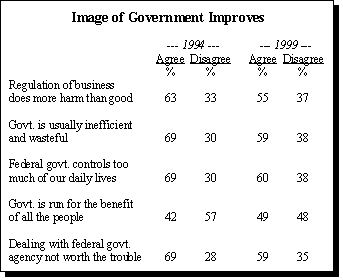
Public attitudes toward government in general have softened as well. Today, Americans split evenly over whether the government is run for the benefit of all people 49% agree; 48% disagree. In 1994, only 42% saw the government as benevolent, while 57% expressed doubts.
Indeed, although the public remains suspicious of governmental power and efficiency, there are clear indications that Americans’ hostility toward government is easing. While 60% of the public still says that the federal government controls too much of our daily lives, this is considerably less than the 69% who said so in 1994. The percent who agree that something run by the government is usually inefficient and wasteful has also fallen: 59% today, compared to 69% in 1994.
This decreasing concern about inefficiency may explain why Americans are more willing to turn toward the federal government than they were in the past. In 1994, 69% of the public said that dealing with a federal agency is often not worth the trouble. Now, that number has dropped to 59%.
The public is also less wary of government regulation of business. Just over half (55%) say that such regulation usually does more harm than good a drop of eight percentage points in five years.
Finally, while Americans continue to favor local government over federal action, even this sentiment is waning somewhat. Today one-third (32%) of the public completely agrees with the statement that the federal government should run only those things that cannot be run at the local level. In 1994, fully 38% completely agreed with this assertion.
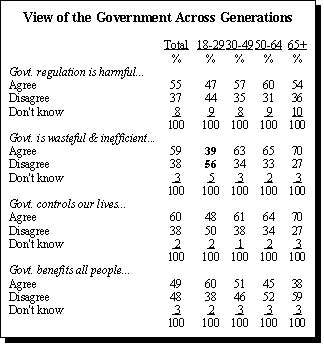
In general, Americans ages 18-29 have more positive attitudes toward government than does any other generation. They are less concerned about government regulation of business, less likely to consider government-run operations as inefficient and less worried that government has excessive control.
While this was true in 1994 as well, some of the greatest declines in hostility toward government have occurred among the 18-29 year-old generation. For example, the 39% of young adults who agree that something run by the government is usually inefficient and wasteful is significantly less than the 55% who said so in 1994. Among the older generations, hostility has eased considerably less.
Political Change Less Urgent
As cynicism toward politics and skepticism toward government have eased, so has the desire for political change. While most Americans (73%) still agree that Washington politicians should step aside and make room for new leaders, this number has fallen from the 79% who said so in 1994. The percent who completely agree with the need to replace current leaders has fallen to 29% today from 34% five years ago.
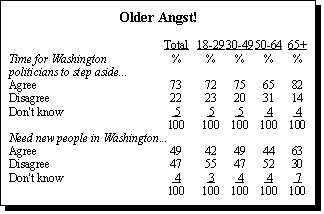
Moreover, Americans are less enthusiastic about sweeping change and more concerned about the possible costs of such upheaval: 49% say new people are needed even if they are not as effective as experienced politicians; 47% disagree. In 1994, six-in-ten favored change over experience, just 38% opposed it.
Senior citizens are the most supportive of political change — a generation gap that has increased in the past five years. For example, almost two-thirds (63%) of those 65 and older favor new people over experienced politicians but less than half of any other age group agrees. Moreover, while younger generations are significantly less supportive of change now than they were in 1994, there has been little or no movement along these lines among seniors.
Compassion Rising

Change in public sentiment about politics and government extends to the spending of government funds. At the end of the century, the public expresses a growing willingness to use government to help the less fortunate.
Americans express greater compassion in this regard in 1999 than they did just five years ago. Almost half (49%) of the public says that the government should help more needy people, even if it means going deeper in debt; 47% disagree. In 1994, Americans divided 41% in favor and 56% against this aid. Similarly, more Americans now say the government should take care of those who can’t take care of themselves: 62% agree, compared to 57% who did so in 1994. In addition, more people now say that the government should guarantee every citizen enough to eat and a place to sleep: 64% agree, compared to 59% five years ago.
Despite this growing desire to use government to assist those in need, the public remains concerned about the poor’s over-reliance on government. Three-quarters (77%) agree, including 34% who completely agree, that poor people have become too dependent on government programs. Yet, even this belief has eased somewhat in 1994, fully 85% of Americans agreed with this statement, 46% completely agreed.
The public’s growing compassion extends to those outside of our borders as well. Americans express less hostility toward immigrants than they did just five years ago. Today, 72% of the public agrees with stricter immigration restrictions, 38% completely agree. In 1994, these numbers were 82% and 47%, respectively.
Prosperity and the American Dream
Americans’ growing compassion may stem from the economic prosperity of the late 1990s. Two-thirds (68%) say they are financially satisfied. Indeed, only about one-third (31%) of the public feels financially strapped. Just 36% say that they often don’t have enough money to make ends meet — the lowest number recorded in the 12 years that the Center has asked this question. In 1994, fully 43% of the public felt financially pressed.
Americans also express a growing faith in the possibility of achieving success. Seven-in-ten (69%) see a connection between hard work and success; in 1994, six-in-ten did. Similarly, by a 67%-to-32% margin, Americans reject the notion that success in life is determined by forces outside of our control. In 1994, this was a closer contest, with 59% disagreeing and 39% agreeing.
Contentment and Indifference
The public’s milder stance toward government and politics appears linked to less interest in political and national news. Americans express increasing disinterest in and detachment from national affairs.
In 1994, 46% of the public said they followed what’s going on in government and public affairs most of the time; the same number described themselves as interested in keeping up with national affairs. Now, just 39% say they follow government and public affairs most of the time and even fewer (37%) are interested in national news.
Fully 58% of Americans say they are generally bored by what goes on in Washington, a jump from the 51% majority who said so five years ago. And growing numbers say national politics is irrelevant: 38% say that issues discussed in the nation’s capital don’t affect them personally, an increase from the 30% who said so in 1994.
Even interest in local news traditionally a bigger draw has fallen off. Two-thirds (66%) of the public is interested in following local politics, a drop from the three-quarters (76%) who expressed this interest in 1994.
Two Minds About Big Business
Most Americans continue to see American business as central to our national strength, but they also maintain their concerns about the size of corporate profits and the disproportionate power of big companies. For example, while 76% of the public says that the strength of the country today is based on the success of American business, almost as many (74%) say that there is too much power concentrated in the hands of a few companies. (Both numbers have changed little since 1994.)
While many Americans have benefitted from a booming stock market, the public continues to have reservations about corporate profits. Today, 56% say business corporations make too much profit, down somewhat from 61% in 1994. Moreover, Americans remain divided over corporate attempts to strike a fair balance between profits and the public interest: 45% say business achieves this task; 50% say it falls short.
Black and White Views on Racial Issues
Blacks and whites are often in sharp disagreement over both the treatment of African-Americans in today’s society and possible solutions to end racial discrimination. Some of this difference of opinion occurs only on the extremes, while other gaps create central divisions between the races.
For example, while most blacks and whites reject the notion that racial discrimination against blacks is rare today, African-Americans are twice as likely as whites to feel strongly about this. About three-quarters of each group disagrees with the statement that discrimination against blacks is rare today but 47% of blacks completely disagree, compared to just 23% of whites.
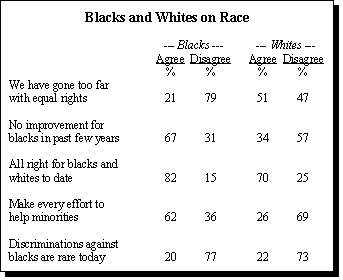
More striking, however, is the contrast between black and white opinions over how much progress African-Americans have achieved. Two-thirds (67%) of blacks say that there has not been much real improvement in the position of blacks in society; only one-third (34%) of whites agree with this assessment. Similarly, while whites are divided 51%-to-47% over whether we have gone too far pushing equal rights, blacks are solidly against this assertion, with 79% in disagreement and just 21% in support. Finally, African-Americans support for preferential treatment (62% in favor) is almost as strong as white opposition (69% oppose it).
An area of agreement is interracial dating: solid majorities of both whites and blacks approve, 70% and 82% respectively. Among the general population, fully 73% approve of interracial dating, a number that has risen steadily since 1987, when just under half (48%) approved.
Americans acknowledge racial discrimination as a less-than-rare occurrence but reject attempts to use affirmative action as a solution to this problem. For example, while most of the public (73%) disagrees with the notion that discrimination against blacks is rare today, preferential treatment of blacks and other minorities is rejected by a 65%-to-31% margin.
This division may be due in part to disagreement over whether African-Americans continue to be as disadvantaged as they once were. A narrow 53% majority of the public says there has been real improvement in the position of blacks in society, but 38% disagree.
Gay Acceptance
Over the past 12 years, Americans have slowly and steadily changed their attitudes toward the treatment of homosexuals. Currently, six-in-ten (62%) oppose school boards firing known homosexuals; in 1987, only 42% opposed such firings. Similarly, while only one-third (32%) of the public now says that AIDS is God’s punishment for immoral behavior, in 1987 43% viewed AIDS as punishment.
Americans are largely divided over other civil liberty issues. On balance, the public supports banning books with dangerous ideas (55%-43%) and declares nude magazines and X-rated movies to be harmful (53%-43%). Slightly more (57%) say freedom of speech should apply to groups such as communists and the Ku Klux Klan, but a solid 39% minority is willing to deny them this right.
One of the most divisive issues is the use of police force in the war on drugs: 45% of the public says that police should be allowed to search houses of known drug dealers without court orders; 53% say they should not. This balance has shifted a bit since 1994, when the public divided 51% in support of searches and 48% against them.
American Exceptionalism
The economic boom of the late 1990s has neither diminished nor enhanced Americans’ faith in the exceptionalism of the United States. Seven-in-ten agree that as Americans we can always find a way to solve our problems and get what we want. Six-in-ten (62%) don’t believe there are any limits to growth.
The public of the late 1990s expresses a strong connection to the values and traditions of earlier times. More than eight-in-ten (84%) say they have old-fashioned values about family and marriage. Three-quarters agree that too many children are being raised in day care centers. This appreciation for conventional values does not extend to all areas of family life, however. Only one-quarter of the public says that women should return to their traditional roles in society.
Religious Faith

Americans remain a religious people both in faith and practice. Fully 88% say they never doubt the existence of God. More than eight-in-ten (84%) believe that God continues to perform miracles; nearly the same percent (83%) expect to answer for their sins before God on Judgment Day. Over three-quarters (78%) say that prayer is an important part of their daily lives.
America’s Role in the World
In overwhelming numbers the public continues to support an active world role for the United States — fully 88% agree that such a position is in the best interests of our country. At the same time, however, Americans are adamant in their belief that we should emphasize national problems over international concerns eight-in-ten support this assertion.
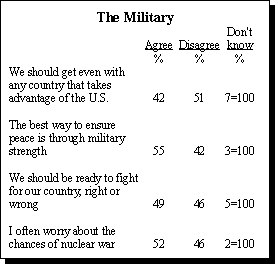
Issues of military power and prowess divide the public, with no position drawing an overwhelmingly strong level of support. A narrow 51%-to-42% majority rejects the notion that the Unites States should get even with any country that takes advantage of it. Americans are similarly split over the connection between military strength and peace: 55% say military strength is the best way to ensure peace; 42% disagree.
Similarly, just under half (49%) of the public says we should all be willing to fight for our country, whether it is right or wrong, but almost as many (46%) disagree with this obligation.
Even the threat of war isn’t viewed equally by the public. Almost as many Americans often worry about the chances of nuclear war as don’t, 52% vs. 46%, respectively.
The Values Gap
The gender gap, so apparent in party identification and basic political views, has its underpinnings in important differences between men and women on certain fundamental values. Men and women differ most dramatically on the role of government, morality and America’s position in the world.
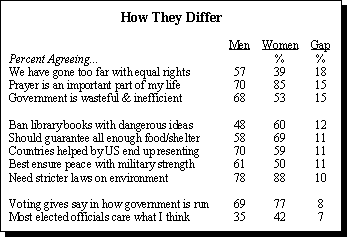
Women have more positive views on government and favor a more activist government than do men. Fewer women than men completely agree that elected officials lose touch with people (25% to 32%, respectively). Women more than men believe that voting gives a say in how the government is run. More than two-thirds (68%) of men believe that anything run by the government is wasteful and inefficient in contrast to 53% of women. In addition, slightly more men than women agree that government regulation of business does more harm than good (59% and 52%, respectively).
On the issue of environmental protection, men agree with women that people should pay higher prices to help the environment (56% and 57%, respectively). However, men are not as insistent as women that there should be stricter laws governing the environment (78% and 88%, respectively).
With regard to the poor, men agree with women that the government should help those who cannot take care of themselves (61% and 63%, respectively). Men are more hesitant, however, about the government guaranteeing every citizen a place to sleep and enough to eat compared to women (58% and 69%).
Women continue to express more religious devotion than men, with nearly two-thirds (63%) saying they completely agree that prayer is an important part of their daily lives compared to 45% of men. Nearly six-in-ten (58%) women completely agree they have old-fashioned values on marriage compared to 48% of men. Fewer women than men see nude magazines and X-rated movies as harmless entertainment (37% and 51%, respectively), and more women agree that certain books should be banned from public libraries (60% and 48%, respectively).
Men express slightly more patriotism than women, and they are also more militaristic. In addition, more men than women are in favor of restricting and controlling the number of people coming into this country.